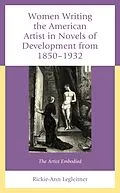In nineteenth- and early twentieth-century artist novels, American women writers challenge cultural, social, and legal systems that attempt to limit or diminish women's embodied capabilities outside of the domestic. Women writers such as E.D.E.N. Southworth, Elizabeth Stuart Phelps, Kate Chopin, Willa Cather, Jessie Fauset, and Zelda Fitzgerald use the artist novel to highlight the structural and material limitations that women artists face when attempting to achieve critical success while navigating inequitable marriages and social codes that restrict women's mobility, education, and pursuit of vocation. These artist-rebel protagonists find that their very bodies demand an outlet to articulate desires that defy patriarchal rhetoric, and this demand becomes an artistic drive to express an embodied knowledge through artistic invention. Ultimately, these women writers empower their heroines to move beyond prescribed patriarchal identities in order to achieve autonomous subjectivity through their artistic development, challenging stereotypes surrounding gender, race, and ability and beginning to reshape cultural notions of marriage, motherhood, and artistry at the turn of the twentieth century.
Autorentext
Rickie-Ann Legleitner is assistant professor of English and director of women's, gender, and sexuality studies at the University of Wisconsin, Stout.
Klappentext
From 1850-1932, American women artists found their bodies and desires narrowly defined by cultural, social, and legal patriarchal systems. Women were typically depicted as "abnormal" for harboring desires that lay outside of motherhood, yet female coming-of-age stories complicate this rhetoric by revealing how the roles of wife and mother are themselves "abnormal" in their self-sacrificial demands. The Artist Embodied: The Development of Women Artists in American Literature from 1850-1940 contends that in the female Künstlerromane, or artist novels, the protagonist's body demands an outlet to articulate desires that defy restricting patriarchal rhetoric. This demand becomes an artistic drive to express an embodied knowledge in a new language of artistic invention that establishes the female body as generative beyond corporeal reproduction.This book explores the development of the female artist in American literature by women writers, including the work of E.D.E.N Southworth, Elizabeth Stuart Phelps, Kate Chopin, Willa Cather, Jessie Fauset, and Zelda Fitzgerald. Each of these authors depicts the coming-of-age of women artists to assert the legitimacy of their art, pushing back against the erroneous notion that women are, at best, talented hobbyists, and, at worst, a scribbling mob drawing attention away from more substantial works by critically acclaimed male authors.
Inhalt
Chapter One: Individuality and the Embodiment of Inequality in E.D.E.N. Southworth's The Deserted Wife
Chapter Two: Disabling Marriage and the Woman Artist in Elizabeth Stuart Phelps's The Story of Avis
Chapter Three: Embracing Fate: Artistry and Autonomy in Kate Chopin's The Awakening
Chapter Four: 'That sensuous form': Corporeal Artistic Creation in Willa Cather's The Song of the Lark
Chapter Five: The Body at Play: Artistic Passing in Jessie Fauset's Plum Bun
Chapter Six: The Cult of Artistry in Zelda Fitzgerald's Save me the Waltz
